Llança
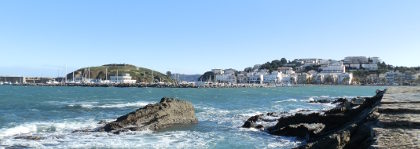 Llança is in the northern part of the Costa Brava between Cap de Creus and France. It is on the train line from Figueres to Cerbere and so easily accessible by public transport. Until recently this was the only trainline out from Spain to France on the Mediterranean side but from Llança north it is a slow and steady journey along the coast. There is also a road that follows the coast, weaving and bending with the rugged coastline by hills of low scrub and olive groves - again not a journey if you want to travel quickly.
Llança is in the northern part of the Costa Brava between Cap de Creus and France. It is on the train line from Figueres to Cerbere and so easily accessible by public transport. Until recently this was the only trainline out from Spain to France on the Mediterranean side but from Llança north it is a slow and steady journey along the coast. There is also a road that follows the coast, weaving and bending with the rugged coastline by hills of low scrub and olive groves - again not a journey if you want to travel quickly.
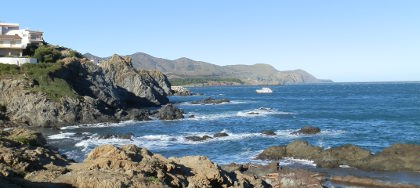 Llança, like it's neighbour Port de La Selva, has the feeling of a harsher landscape than the gentler fields and welcoming calas further south - there is an air of untamed wildness in the scrub-covered hills and the rough rocks that jut at angles leaving sharp edges. The sand is dark grey, soft in places, but pebbly in others. This wildness which was increased for us by the strong wind and white horses on the sea and the fill of driftwood from the recent storms that scattered across the beaches.
Llança, like it's neighbour Port de La Selva, has the feeling of a harsher landscape than the gentler fields and welcoming calas further south - there is an air of untamed wildness in the scrub-covered hills and the rough rocks that jut at angles leaving sharp edges. The sand is dark grey, soft in places, but pebbly in others. This wildness which was increased for us by the strong wind and white horses on the sea and the fill of driftwood from the recent storms that scattered across the beaches.
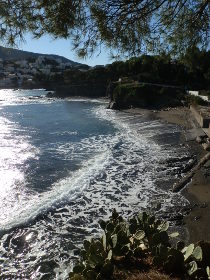 We're a little behind on our walks over the last month. The early part of November was unseasonably hot, with people sunbathing and swimming in the sea in the first week of November. And then rain and fog came (including floods in Figueres) which, combined with being a taxi service for some very active children, meant that we've been walking closer to home and revisiting walks we've already added.
We're a little behind on our walks over the last month. The early part of November was unseasonably hot, with people sunbathing and swimming in the sea in the first week of November. And then rain and fog came (including floods in Figueres) which, combined with being a taxi service for some very active children, meant that we've been walking closer to home and revisiting walks we've already added.
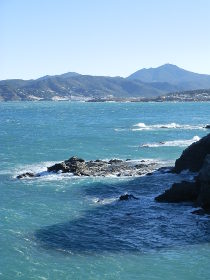 This weekend though, blue sky is back and the autumn temperatures have returned to something normal for the time of year (more 14-17C) and for the first time this autumn we have our mountains back - the crystal clear views to the Pyrenees that we get once the dusty haze of the summer blows away. There's snow too. Canigou's white top can be seen from the Palafrugell to La Bisbal road again.
This weekend though, blue sky is back and the autumn temperatures have returned to something normal for the time of year (more 14-17C) and for the first time this autumn we have our mountains back - the crystal clear views to the Pyrenees that we get once the dusty haze of the summer blows away. There's snow too. Canigou's white top can be seen from the Palafrugell to La Bisbal road again.
So we're up to visit Llança. The town is slightly separate from the port, so we park near the Port in a strong Traumuntana wind which is whipping up the sea. From the car park we walk to the sea itself for some bracing sea air, then follow the promenade past the modern houses which faces the nest of buildings of Port de Llança and the small marina in front of us. Behind us, the hills climb to the back of the housing estate and along the coast we get views of the windswept headlands towards France. And out at sea there are some hardy souls on jetskis using the rough conditions for jumping.
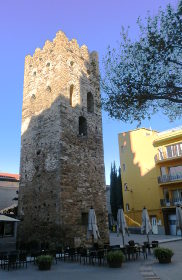 A bridge crosses a small river into the bay of the port, which has a crescent shaped sandy beach in the dark sand typical of this area. Ahead of us is a small hill (the Castellar) with a number of people out for a breezy sunday afternoon stroll. We walk up the hill and get views up the coast to Port de la Selva. The village of the Port is separate from the main town of Llança and consists of a small nucleas of houses, bars, restaurants and shops that climb up on the headland.
A bridge crosses a small river into the bay of the port, which has a crescent shaped sandy beach in the dark sand typical of this area. Ahead of us is a small hill (the Castellar) with a number of people out for a breezy sunday afternoon stroll. We walk up the hill and get views up the coast to Port de la Selva. The village of the Port is separate from the main town of Llança and consists of a small nucleas of houses, bars, restaurants and shops that climb up on the headland.
There is a marked coastal path (green-red), however from the port side closest to the sea, the route has been blocked, so we have to navigate through the streets up the hill of the headland. At the top we find the path continues above the cliffs with pre-prepared steps, but the wind is sufficiently strong that we actually stick to the estate roads among the houses and villas until we reach a lower point (it's not particularly high, but the wind was quite fierce).
After curling through the streets we navigate back towards the sea and reconnect with the coastal path, following it around the rocky headlands. The stones and rocks in this area are quite dark and jagged with sharp corners so we stick to the path. It follows around a number of small bays with beaches of grey sand in places, pebbles in others.
The storms have brought driftwood in to the bays and they are littered with trees and branches washed clean by the sea, lying among seaweed that lends a nautical smell like an English beach. The path is undergoing some recontruction, but we walk round with no problem coming to Platja les Tonyines before turning back to the town above Cala de la Loup.
We walk the straightest route to town along a relatively plain street, heading directly for the church. The inner part of Llança has a core of small streets, in amongst shops and a commercial district. The church is quite grand and stands next to an old Romanic tower in a placa in the centre of the town.
We're suffering from wind noise and so don't explore too much, but instead head back to the port.
Neighbouring walks: Port de la Selva - Espolla to Rabos - Cadaques and Port Lligat - Sant Pere de Rodes - Figueres and Castell de Sant Ferran - Cadaques to Roses - Peralada - La Jonquera to Fort de Bellegarde (France) - Collioure (France) - Portbou to Cerbère (France) and back
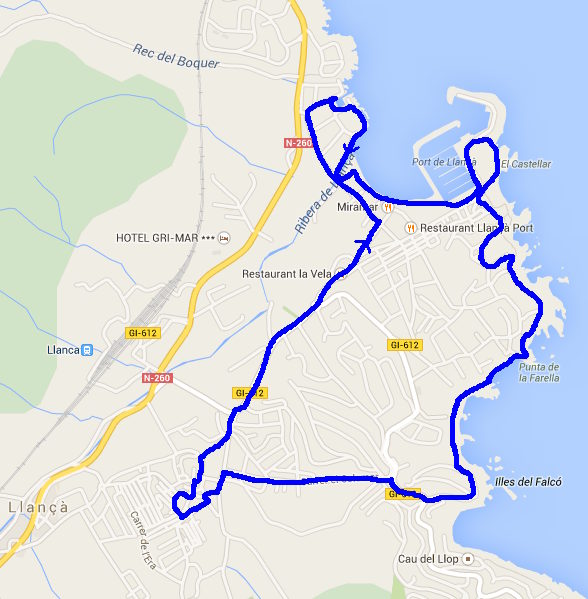

 Walks and other things
Walks and other things